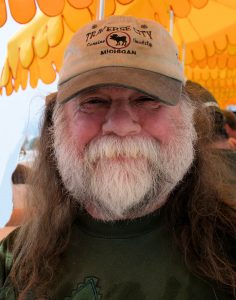Piracy on the Great Lakes — Mikel B. Classen (Mathieu | Project #1)
 In a recent interview on the Mathieu | Project channel I talked about a subject that has fascinated me for decades: Piracy on the Great Lakes: True Tales of Freshwater Pirates. As an author, historian, journalist and photographer raised in Michigan’s Upper Peninsula, I’ve spent years chasing stories that many people assume belong only to the Caribbean. What I found instead is a long, messy, often overlooked tradition of theft, violence, and improvisation that followed the rhythms of inland commerce—from the fur trade to prohibition-era smuggling.
In a recent interview on the Mathieu | Project channel I talked about a subject that has fascinated me for decades: Piracy on the Great Lakes: True Tales of Freshwater Pirates. As an author, historian, journalist and photographer raised in Michigan’s Upper Peninsula, I’ve spent years chasing stories that many people assume belong only to the Caribbean. What I found instead is a long, messy, often overlooked tradition of theft, violence, and improvisation that followed the rhythms of inland commerce—from the fur trade to prohibition-era smuggling.
Why Great Lakes piracy matters
Most people picture pirates with tropical islands, Spanish galleons and heaps of gold. The Great Lakes had none of that Spanish treasure, but they did have something just as valuable in context: furs, timber, payrolls, and the shipment of everyday commodities. Where there’s water, people take advantage of it—“where there’s water, there’s been pirates,” as I like to say. These pirates didn’t just steal for sport. They exploited markets, legal gray areas, and the slow spread of maritime law across a vast inland sea.
The long arc: from fur traders to rum runners
Piracy on the lakes stretches across several eras:
- Fur trade piracy — rivalry between the Northwest Company and the Hudson’s Bay Company led to armed raids on canoes and batteaux, sometimes with massacres and large-scale theft.
- Timber piracy — thieves cut federal timber and shipped it out to feed booming settlements; locals often sympathized because they wanted the land cleared.
- Prohibition and smuggling — alcohol, payrolls, and other contraband created opportunities for organized theft and violence along shorelines and island chains.
Across these periods pirates adapted to what was available. Sometimes that meant stealing beaver pelts; other times it meant stripping a dockside town of everything not bolted down and selling it at the next port.
Law on the lakes: the lonely USS Michigan
For much of the 19th century the USS Michigan was the only federal maritime presence patrolling all five Great Lakes. It was powerful for its time—an ironclad steam-and-sail warship—but it was impossible for one vessel to cover a theater that huge. The result: when the Michigan was in one place, other lakes were often wide open to a free-for-all.
Opportunists and organized outlaws
Most Great Lakes pirates were opportunistic: small crews, quick raids, hit-and-run tactics. But some figures organized fleets and exercised real territorial control. Two examples that show the range:
- James Jesse Strang — a charismatic Mormon leader who proclaimed himself king on the Beaver Islands. Strang ran a fleet, painted sails black, issued his own money and enforced strict laws on islanders. What began as a religious movement took on the trappings of power and, eventually, brutality.
- Dan “Roaring Dan” Seavey — a classic opportunist from Escanaba who looted ports and ships, eventually even standing trial for piracy—uniquely, the only Great Lakes pirate to be prosecuted for piracy in my research. Acquitted, he was later made a U.S. marshal; the experiment failed spectacularly when his old habits resurfaced.
 When commerce looked like warfare
When commerce looked like warfare
During the fur trade the fight for pelts often resembled corporate warfare. Big trading companies treated furs as strategic assets and attacked each other’s supply lines. The boats used—canots and large canoes up to 65 feet long—could carry tons of fur and were frequent targets. Native trappers sometimes shifted allegiances or participated directly because European trade goods (blankets, knives, metal tools) were extremely valuable.
Famous—and ambiguous—episodes
Not all stories are cleanly documented. Some live between legend and record:
The Apostle Island pirates
Local histories suggest a band of French pirates named after the apostles—John, Paul, Luke, Matthew—with a leader called “the Chief.” They allegedly robbed a payroll bound for a French fort, were hunted down from Montreal, and mostly hanged. The tale fits the islands’ geography, but contemporary evidence is sparse; it could be true, partly true, or a neat local legend that explains the islands’ name.
William Johnson, the St. Lawrence pirate
Johnson operated in the Thousand Islands, a labyrinth of hiding places that straddled the U.S.–Canada border. He claimed to be leading a Canadian revolution—complete with a forged commission—using political ambiguity to thwart prosecutors. His daughter Kate became known as the “Queen of the Thousand Islands,” serving as a spy and intelligence gatherer. Johnson’s con-man style made him hard to prosecute.
James Jesse Strang: faith, power, greed
Strang is one of the most cinematic characters I encountered. He began preaching that he’d received revelations and that the islands belonged to his followers. Over time faith hardened into control: forced polygamy, printed proclamations, black sails, and coercion. He ruled the Beaver Islands like a theocratic tyrant until he was assassinated on a dock near the USS Michigan—an episode some believe involved government complicity because the killers were treated leniently afterwards.
“He would give you the shirt off his back and then turn around and steal it back.”
That line came from contemporary descriptions of Dan Seavey and captures the mix of charm and duplicity many of these men possessed.
Dan Seavey: outlaw to U.S. marshal—and back
Seavey’s life reads like a short novel. Accused of stealing the schooner Nelly Johnson (he claimed he won it in a poker game), he was tried and acquitted—largely because witnesses vanished. Officials made him a U.S. marshal in a classic “if you can’t beat him, co-opt him” move. It didn’t work: at a bar fight he killed a man by dropping a piano leg onto his head. That was the end of his marshaling career and a return to violence.
Timber pirates and frontier morality
Timber theft is a great example of moral ambiguity on the frontier. Settlers wanted trees gone so they could farm and build. Federal land ownership didn’t match local needs or sympathies. Pirates would cut federal timber, load it, and ship it away; many locals resented enforcement and even helped pirates escape custody. To communities desperate for cleared land, timber pirates were often useful—if not lawful.
Treasure legends: Poverty Island, Beaver Island
People love treasure stories. I’ve followed rumors—boxes with chains lost near Poverty Island, claims of Civil War–era shipments from France containing gold, and artifacts left behind by the Mormon exodus from Beaver Island. Salvagers and treasure hunters have reported finds, but credible evidence remains elusive. The Great Lakes are full of shipwrecks; identifying the right wreck is hard, and most legends turn out to be just that.
Research difficulties: language, sources and dime novels
Verifying these crimes is hard because pirates preferred secrecy and many early records are thin. Challenges include:
- Scarcity of newspapers before the mid-1800s—upper peninsula papers really don’t start until around 1853.
- Primary accounts in French, Jesuit records, or sparse voyage journals that require careful translation and context.
- Later embellishments and dime novels—especially for figures like Bully Hayes—that blur fact and fiction.
To build credible narratives I rely on contemporary newspaper accounts, courthouse records where available, oral histories, centennial community books, and historic photographs. Collecting small, out-of-print community histories has turned up priceless leads.
Images and eyewitness voices
Photographs and eyewitness accounts anchor shy legends in reality. I collect historical photos and rare community books—sometimes printed in tiny runs for local anniversaries—and use them to trace dates, places and names. Often a single image or local centennial paragraph gives enough detail to find a corroborating newspaper or court record.
Telling the story without losing the facts
I’m a storyteller at heart, but history needs a foundation. My approach is to present the narrative voice—eyewitnesses, contemporary reporters—while insisting on documentary verification where possible. If a myth is wrong, I try to set it straight and replace it with the best-supported version of events. That balance is crucial: the tales should be lively, but they must be defensible.
Lessons the pirates leave us
What do these stories tell us today?
- Opportunity breeds transgression. Wherever commerce is free and enforcement weak, people will exploit gaps for profit.
- Moral gray areas thrive on local sympathies—timber pirates were sometimes community allies because they cleared land.
- Crime sometimes pays, at least temporarily. Many of these men died free, wealthy, or simply vanished from records.
- Finally, these stories are part of a broader American outlaw spirit—frontier improvisation, lawlessness, and reinvention.
Who would make a good movie—and a bad dinner guest?
If Hollywood asked me, James Jesse Strang and Dan Seavey would be movie protagonists: drama, charisma, contradictions, and public spectacle. For the worst dinner guest, Strang tops the list—his preaching and political control could make any meal an ordeal.
What I’m working on next
There won’t be a direct sequel to the piracy book—unless I unearth more significant characters—but I’m expanding my True Tales series on forgotten Upper Peninsula history. Volume Two includes 17 stories, among them a Jesse James–style train robbery that netted $70,000 and drew William Pinkerton, son of Allan Pinkerton, to the UP to investigate.
I’m also working on a Great Lakes–wide history of whaleback ships—strange, low-riding freighters developed in Superior, Wisconsin. They look like submarines, rode very low in the water, and are the evolutionary ancestor of later lake freighters. I’ve gathered some 30 rare images of whalebacks and am piecing together their story.
Where to find more
If you want to hear the full interview I did for Mathieu | Project, it’s available on YouTube (search Mathieu | Project #1 – Mikel B. Classen or use the video link https://www.youtube.com/watch?v=6cvjk_GxDro). For more on my books and photos, visit www.mikelbclassen.com.
Closing thoughts
Piracy on the Great Lakes is not a curiosity tucked into a footnote. It’s a window into how commerce, law, and human ambition interact in frontier spaces. These were people who adapted to local economies, hid in island mazes, and took advantage of slow-moving institutions. They’re not romanticized buccaneers—but they are compelling characters, and their stories tell us a lot about the development of the Midwest and the kinds of choices people make when opportunity, isolation, and incentive collide.
Thanks to Mathieu | Project for the invitation to speak on these tales, and to the many local historians, archivists and collectors whose centennial booklets, photographs, and newspaper clippings make this work possible.




